Numerical Analyses of Wave Generation and Vortex Formation under the Action of Viscous Fluid Flows over a Depression
Abstract
:1. Introduction
2. Mathematical Formulations
2.1. Governing Equations
2.2. Initial and Boundary Conditions
2.2.1. Initial Condition
2.2.2. Boundary Conditions
3. Numerical Method
3.1. Grid Generation and Discretization
3.2. Numerical Procedure
- Solve the kinematic free-surface boundary condition (Equation (A2)) to obtain , and accordingly update from Equation (16e). (Here, the notation of hat “^” represents the provisional solutions).
- Solve the dynamic free-surface boundary conditions (Equations (A3) and (12)) for the values of , and , respectively.
- Update the wall vorticity from Equation (15).
- Regenerate the vertical coordinates (Equation (16)) and calculate the grid metric coefficients (Equation (5)).
- Solve the coupled Equations (1) and (2) to obtain and , respectively, in the flow field.
- Repeat steps 1–5 until converged solutions are obtained.
4. Results
4.1. Model Validations
4.1.1. Free-Surface Wave Generation Due to a Negative Bottom Forcing Function
4.1.2. Vortex Motion Comparison: Pure Lid-Driven Cavity Flow
4.2. Vortical Flows in a Square Cavity with a Free Surface: Fr = 1.0, Re = 5000 and 500
4.3. Free-Surface Elevations for a Square Cavity at Re = 5000 and 500 with Fr = 0.5 to 1.1
4.4. Free-Surface Profiles at Various Fr for Re = 5000 and 500
4.5. Influence of Cavity Depth
5. Conclusions
- This paper numerically explores the properties of a viscous free-surface flow over a cavity, which has never been investigated in the past for the vortex motions and the surface waves produced by a negative forcing. Numerical simulations under the consideration of a fixed cavity and various flow conditions ranging Fr from 0.5 to 1.1 at Re =500 and 5000 are carried out with results presented and discussed.
- Under the condition of Fr = 1.0, the vortical flows in the cavity for the cases of lower value of Re (e.g., Re = 500) are shown to be similar to the classical closed lid-driven cavity flow pattern, where a steady-state solution can be reached. For the case with a higher Re (e.g., Re = 5000), the flow motions, although can establish nearly to a quasi-steady state condition, are more complex and are very different from the patterns of Re = 500. Although the cavity flow can reach the steady state, the free surface will remain unsteady. This is a phenomenon worth exploring, one that not been explored by researchers. Therefore, we attempt to provide further possible phenomena in this area of research. As for the viscous influence on the wave development, at a lower Re, stronger advancing solitary waves are generated, possibly because of the increase in the thickness of the boundary layer on the solid walls and the shallower separation-streamline lid of the cavity. This problem is complicated because of the interaction between waves and vortices. Previous researchers have considered inviscid fluid for this problem. This will be very different from the real situation. Therefore, this paper hopes that research in this area can make further progress to consider the effect of viscosity.
- The wave properties of flows over a cavity is found to resemble those with flows over a hump. The forming of a movable but slightly protruding cavity lid as flows passing over a concavity becomes a forcing mechanism. With the values of Fr ranging from 0.5 to 1.1, a series of cases covering from subcritical to supercritical flow regimes are investigated. The results for the lower subcritical flow (e.g., Fr = 0.5) condition indicate that the water surface is disturbed with very weak undular motions. With an increase of Fr (e.g., up to lower supercritical flow conditions), it is noticed the wave height of the upstream advancing waves (solitons) increases. The time required for the development of each emerging solitary wave is also increased.
- In the literature, the variations in waves caused by flow over depressed terrain have not been widely discussed. When it is, the influence of viscosity is generally missing. Also, this phenomenon is difficult to produce in experiments. That is why the results for cavity flow and free surface were verified separately. We strove to prove the credibility of this model, although indirectly. Therefore, the motivation behind, and purpose of this paper, is to provide some information for investigators who are interested in this issue.
Author Contributions
Funding
Acknowledgments
Conflicts of Interest
Nomenclature
| , | convective coefficients |
| b | shape of bottom object |
| bm | minimum tip of object |
| Fr | Froude number |
| g | gravitational acceleration |
| g ij, f i | geometric coefficients |
| H | non-dimensional still-water depth |
| H* | dimensional still-water depth |
| (i, j) | grid-node indices |
| IM | maximum grid index in x-direction |
| J | Jacobian |
| JM | maximum grid index in y-direction |
| L | length of object |
| unit-normal vector | |
| Re | Reynolds number |
| Relid | Re for lid-driven cavity flow |
| (U, V) | contra-variant fluid velocities |
| U* | dimensional inlet velocity |
| tangential free-surface fluid particle velocity | |
| (x, y) | Cartesian coordinates |
| α | solitary-wave height |
| finite-difference operators | |
| Δ | variable increment |
| Δ n | normal distance between the wall and the adjacent node |
| Laplacian operator | |
| ζ | free-surface elevation |
| ν | kinematic viscosity |
| (ζ, η) | Curvilinear coordinates |
| ν | time in transient curvilinear coordinate system |
| Ψ | Stream function |
| stream function at the first grid node to the wall | |
| ω | vorticity |
Appendix A. Numerical Method for Free-Surface Calculation
References
- Ryzhov, E.A.; Koshel, K.V. Steady and perturbed motion of a point vortex along a boundary with a circular cavity. Phys. Lett. A 2016, 380, 896–902. [Google Scholar] [CrossRef]
- Ryzhov, E.A.; Koshel, K.V.; Sokolovskiy, M.A.; Carton, X. Interaction of an along-shore propagating vortex with a vortex enclosed in a circular bay. Phys. Fluids 2018, 30, 016602. [Google Scholar] [CrossRef]
- Shankar, P.N.; Deshpande, M.D. Fluid mechanics in the driven cavity. Annu. Rev. Fluid Mech. 2000, 32, 93–136. [Google Scholar] [CrossRef]
- Chang, K.; Constantinescu, G.; Park, S.O. Analysis of the flow and mass transfer processes for the incompressible flow past an open cavity with a laminar and a fully turbulent incoming boundary layer. J. Fluid Mech. 2006, 561, 13–145. [Google Scholar] [CrossRef]
- Zhang, X.; Rona, A. An observation of pressure waves around a shallow cavity. J. Sound Vib. 1998, 214, 771–778. [Google Scholar] [CrossRef]
- Fang, L.C.; Nicolaou, D.; Cleaver, J.W. Transient removal of a contaminated fluid from a cavity. Int. J. Heat Fluid Flow 1999, 20, 505–613. [Google Scholar] [CrossRef]
- Fang, L.C.; Nicolaou, D.; Cleaver, J.W. Numerical simulation of time-dependent hydrodynamic removal of a contaminated fluid from a cavity. Int. J. Numer. Meth. Fluids 2003, 42, 1087–1103. [Google Scholar] [CrossRef]
- Van Dyke, M. An Album of Fluid Motion; Parabolic Press: Stanford, CA, USA, 1982. [Google Scholar]
- Erturk, E.; Gokcol, O. Fine grid numerical solutions of triangular cavity flow. The European Physical. J. Appl. Phys. 2007, 38, 97–105. [Google Scholar]
- Chang, M.H.; Cheng, C.H. Predictions of lid-driven flow and heat convection in an arc-shape cavity. Int. Commun. Heat Mass Transf. 1999, 26, 829–838. [Google Scholar] [CrossRef]
- Yin, X.; Kumar, S. Two-dimensional simulations of flow near a cavity and a flexible solid boundary. Phys. Fluids 2006, 18, 063103. [Google Scholar] [CrossRef]
- Khanafer, K.; Aithal, S.M. Laminar mixed convection flow and heat transfer characteristics in a lid driven cavity with a circular cylinder. Int. J. Heat Mass Transf. 2013, 66, 200–209. [Google Scholar] [CrossRef]
- Grilli, S.T.; Vogelmann, S.; Watts, P. Development of a 3D numerical wave tank for modeling tsunami generation by underwater landslide. Eng. Anal. Bound. Elem. 2002, 26, 301–313. [Google Scholar] [CrossRef]
- Adkins, D.; Yan, Y.Y. CFD simulation of fish-like body moving in viscous liquid. J. Bionic Eng. 2006, 3, 147–153. [Google Scholar] [CrossRef]
- Kara, F.; Tang, C.Q.; Vassalos, D. Time domain three-dimensional fully nonlinear computations of steady body–wave interaction problem. Ocean Eng. 2007, 34, 776–789. [Google Scholar] [CrossRef]
- Chang, C.H.; Wang, K.H. Generation of three-dimensional fully nonlinear water waves by a submerged moving object. J. Eng. Mech. 2011, 137, 101–112. [Google Scholar] [CrossRef]
- Hanna, S.N.; Abdel-Malek, M.N.; Abd-el-Malek, M.B. Super-critical free-surface flow over a trapezoidal obstacle. J. Comput. Appl. Math. 1996, 66, 279–291. [Google Scholar] [CrossRef]
- Tzabiras, G.D. A numerical investigation of 2D, steady free surface flows. Int. J. Numer. Methods Fluids 1997, 25, 267–598. [Google Scholar] [CrossRef]
- Wu, D.M.; Wu, T.Y. Three dimensional nonlinear long waves due to moving surface pressure. In Proceedings of the 14th Symposium of Naval Hydrodynamics, Ann Arbor, MI, USA, 1 January 1982; National Academy Press: Washington, DC, USA; pp. 103–129. [Google Scholar]
- Zhang, D.; Chwang, A.T. Generation of solitary waves by forward- and backward-step bottom forcing. J. Fluid Mech. 2001, 432, 341–350. [Google Scholar]
- Grimshaw, R.H.J.; Smith, N. Resonant flow of a stratified fluid over topography. J. Fluid Mech. 1986, 169, 429–464. [Google Scholar] [CrossRef]
- Wu, T.Y. Generation of upstream advancing solitons by moving disturbances. J. Fluid Mech. 1987, 184, 75–99. [Google Scholar] [CrossRef]
- Camassa, R.; Wu, T.Y. Stability of forced steady solitary waves. Philos. Trans. R. Soc. Lond. A 1991, 337, 429–466. [Google Scholar]
- Grimshaw, R.H.J.; Zhang, D.H.; Chow, K.W. Transcritical flow over a hole. Stud. Appl. Math. 2009, 122, 235–248. [Google Scholar] [CrossRef]
- Grimshaw, R.H.J.; Zhang, D.H.; Chow, K.W. Generation of solitary waves by transcritical flow over a step. J. Fluid Mech. 2007, 587, 235–254. [Google Scholar] [CrossRef]
- Xu, G.D.; Meng, Q. Waves induced by a two-dimensional foil advancing in shallow water. Eng. Anal. Bound. Elem. 2016, 64, 150–157. [Google Scholar] [CrossRef]
- Chang, C.H.; Tang, C.J. Viscous effects on nonlinear water waves generated by a submerged body in critical motion. In Proceedings of the 17th National Conference on Theoretical and Applied Mechanics, Taipei, Taiwan, 10–11 December 1993; pp. 35–42. [Google Scholar]
- Zhang, D.; Chwang, A.T. Numerical study of nonlinear shallow water waves produced by a submerged moving disturbance in viscous flow. Phys. Fluids 1996, 8, 147–155. [Google Scholar] [CrossRef]
- Lo, D.C.; Young, D.L. Numerical simulation of solitary waves using Velocity–Vorticity Formulation of Navier–Stokes Equations. J. Eng. Mech. 2006, 132, 211–219. [Google Scholar] [CrossRef]
- Tang, C.J.; Chang, C.H. Flow separation during a solitary wave passing over a submerged obstacle. J. Hydraul. Eng. 1998, 124, 732–749. [Google Scholar] [CrossRef]
- Chang, C.H.; Tang, C.J.; Wang, K.H. Vortex pattern and wave motion produced by a bottom blunt body moving at a critical speed. Comput. Fluids 2011, 44, 267–278. [Google Scholar] [CrossRef]
- Tang, C.J. Free Surface Flow Phenomena ahead of a Two-Dimensional Body in a Viscous Fluid. Ph.D. Thesis, The University of Iowa, Iowa City, Iowa, 1987; pp. 14–15. [Google Scholar]
- Nallasamy, M. Numerical solution of the separation flow due to an obstruction. Comput. Fluids 1986, 14, 59–68. [Google Scholar] [CrossRef]
- Chen, C.J.; Chen, H.C. Finite analytic numerical method for unsteady two-dimensional Navier-Stokes equations. J. Comput. Phys. 1984, 53, 209–226. [Google Scholar] [CrossRef]
- Chang, C.H.; Lin, C. Effect of solitary wave on viscous-fluid flow in bottom cavity. Environ. Fluid Mech. 2015, 15, 1135–1161. [Google Scholar] [CrossRef]
- Lowery, K.; Liapis, S. Free-surface flow over a semi-circular obstruction. Int. J. Numer. Meth. Fluids 1999, 30, 43–63. [Google Scholar] [CrossRef]
- Ghia, U.; Ghia, K.N.; Shin, C.T. High-Re solutions for incompressible flow using the Navier-Stokes equations and a multigrid method. J. Comput. Phys. 1982, 48, 387–411. [Google Scholar] [CrossRef]
- Peng, Y.F.; Shiau, Y.H.; Hwang, R.R. Transition in a 2-D lid-driven cavity flow. Comput. Fluids 2003, 32, 337–352. [Google Scholar] [CrossRef]
- Erturk, E.; Corke, T.C.; Gorke, C. Numerical solutions of 2-D steady incompressible driven cavity flow at high Reynolds numbers. Int. J. Numer. Meth. Fluids 2005, 48, 747–774. [Google Scholar] [CrossRef]
- Lee, S.J.; Yates, G.T.; Wu, T.Y. Experiments and analyses of upstream-advancing solitary waves generated by moving disturbances. J. Fluid Mech. 1989, 199, 569–593. [Google Scholar] [CrossRef]

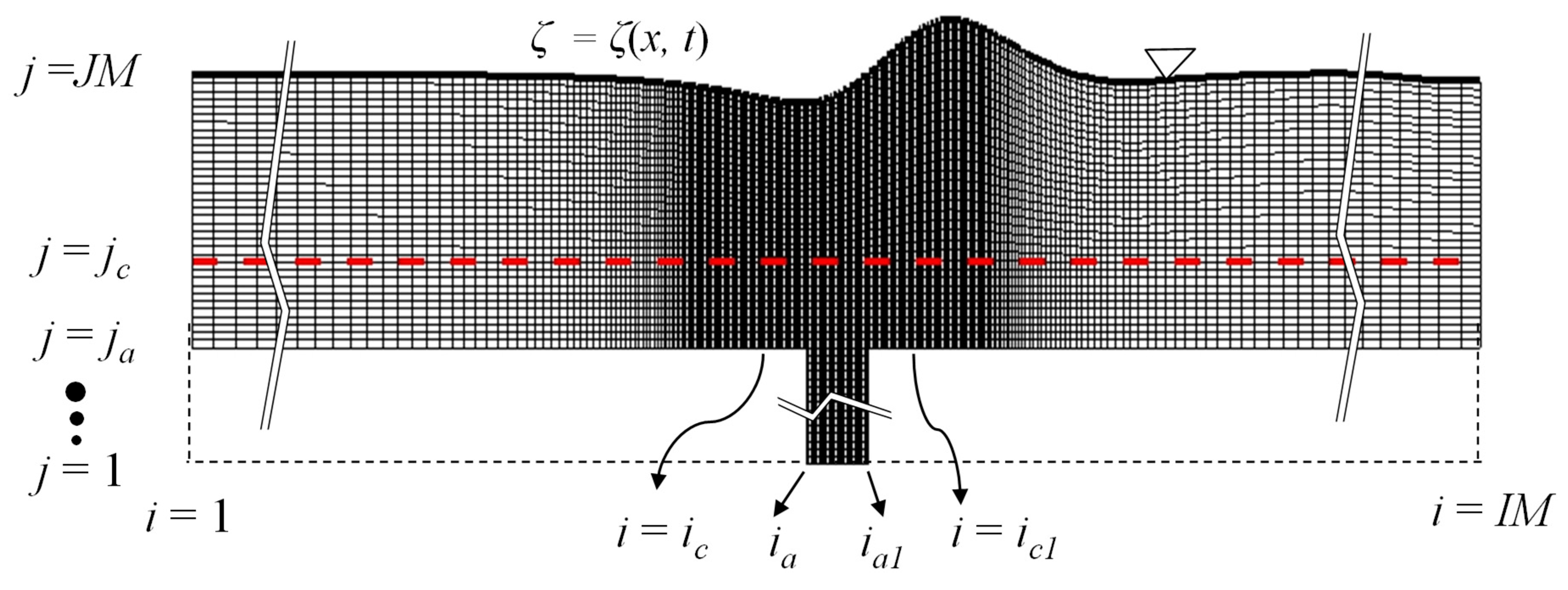

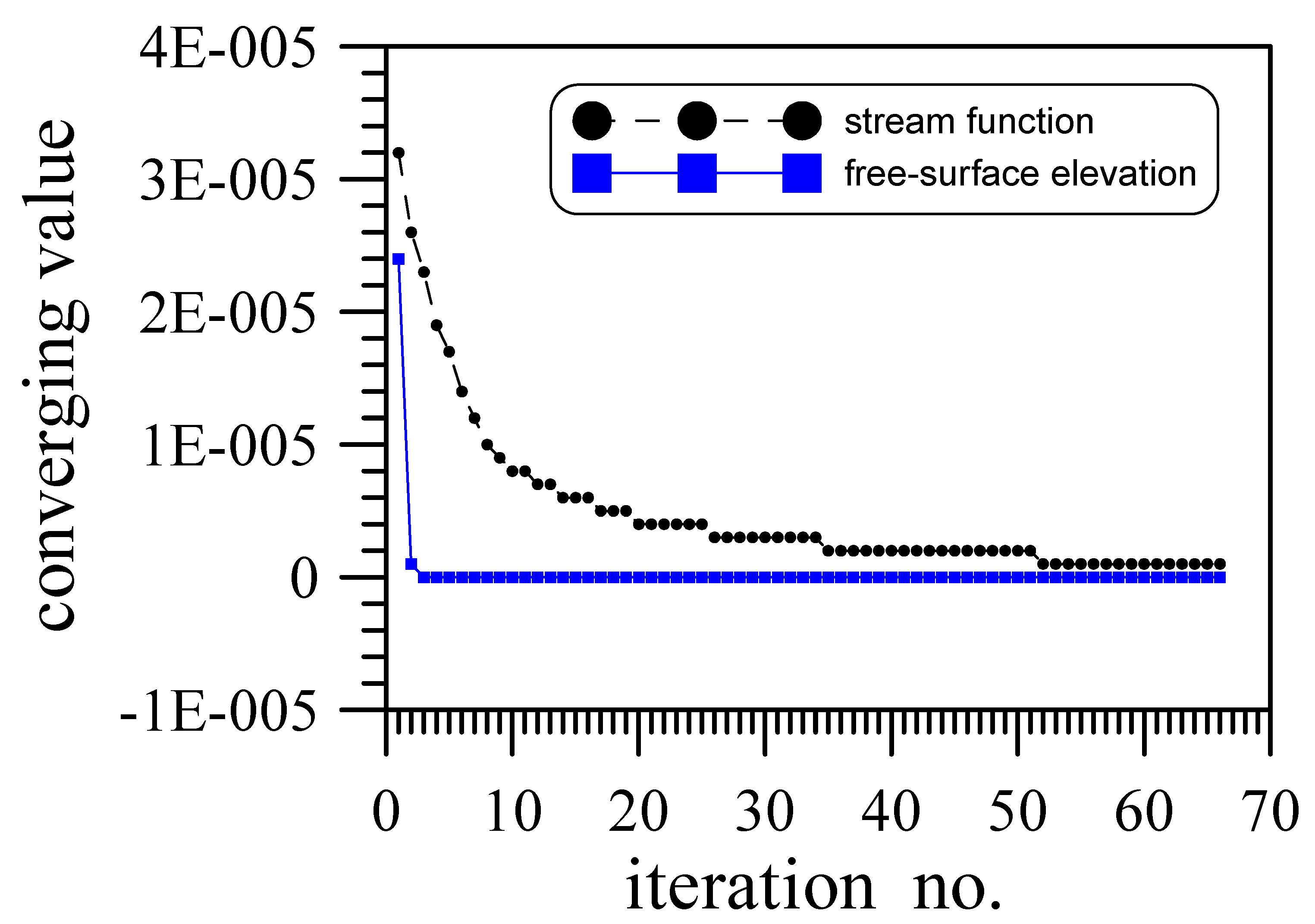




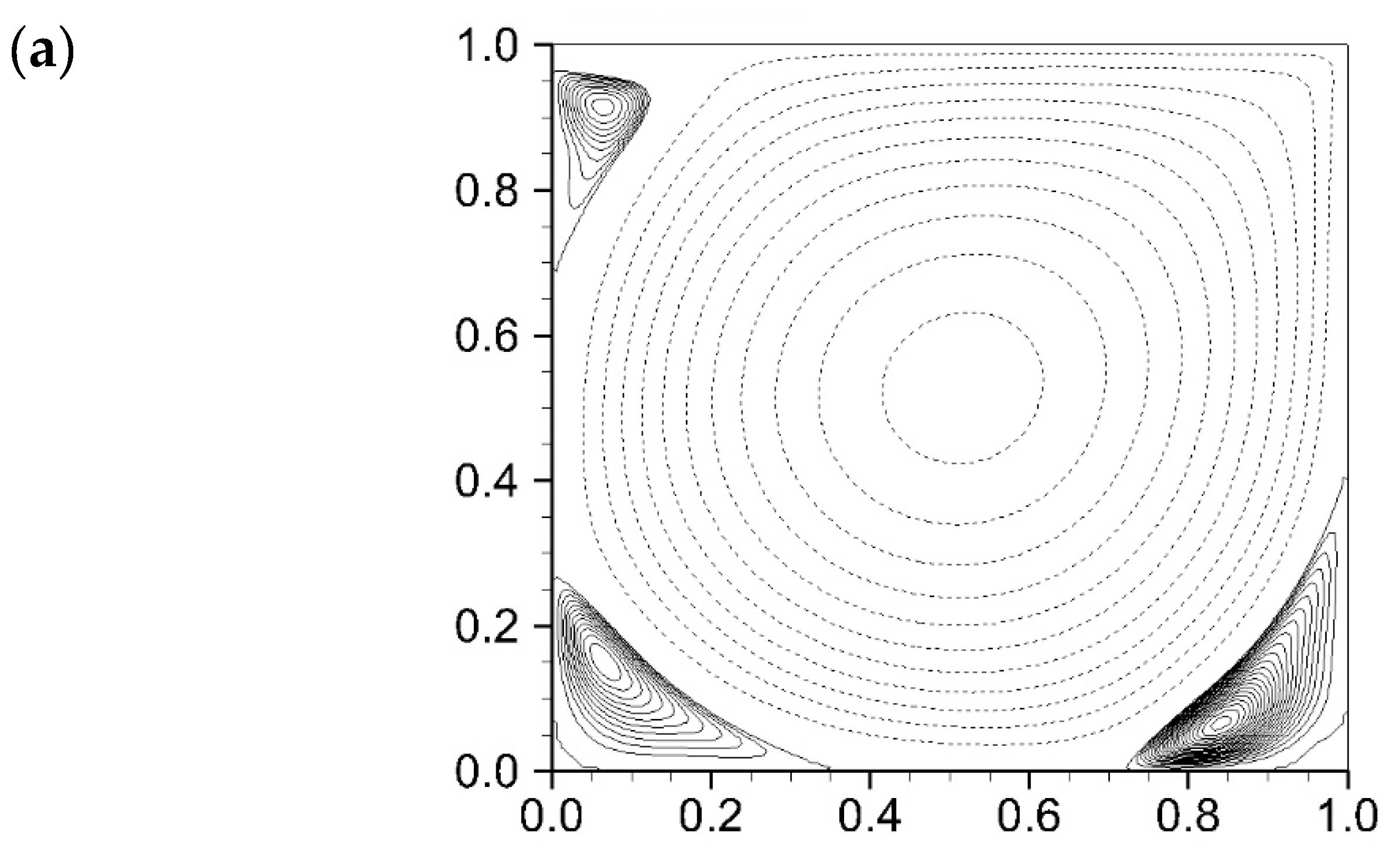

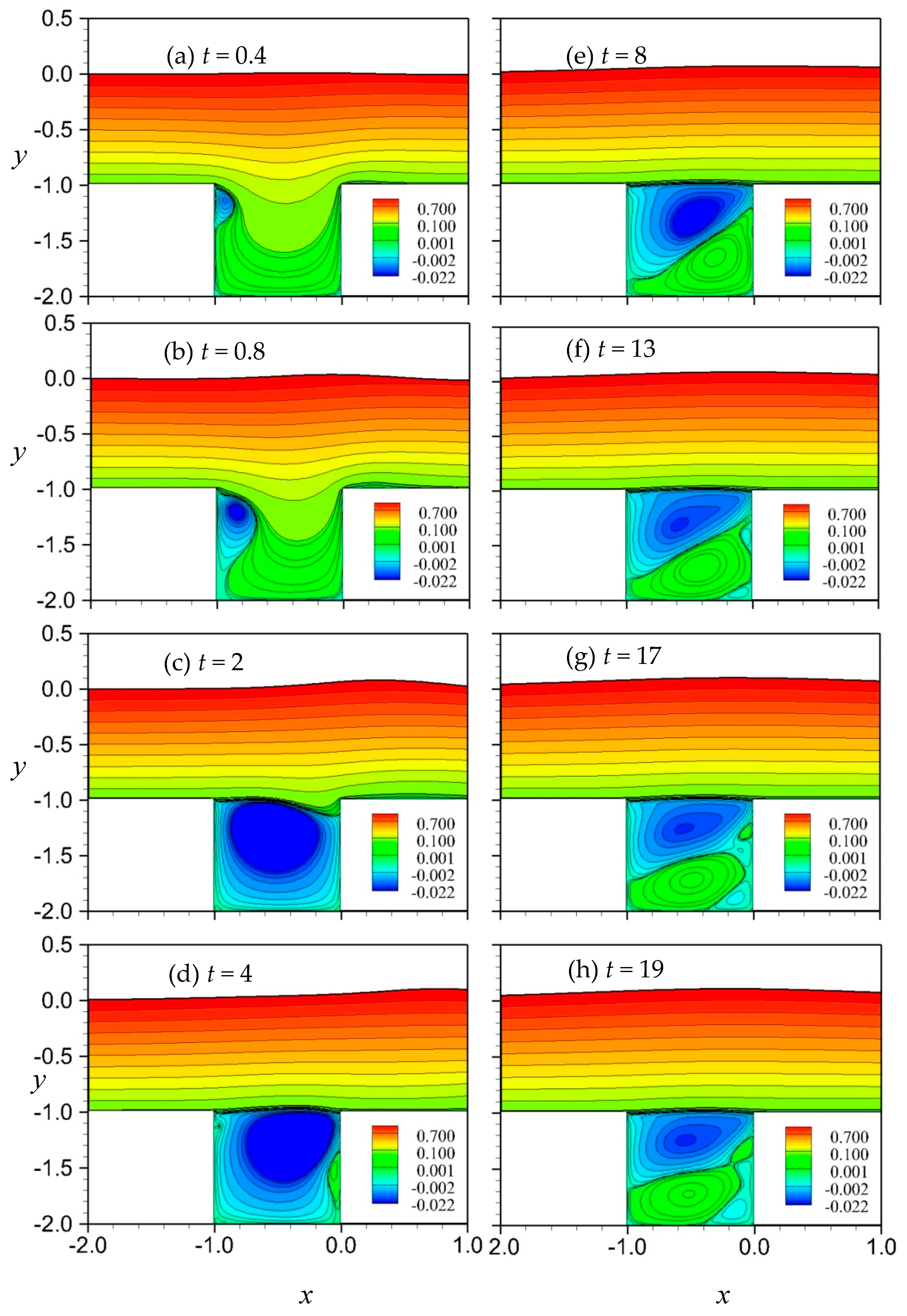

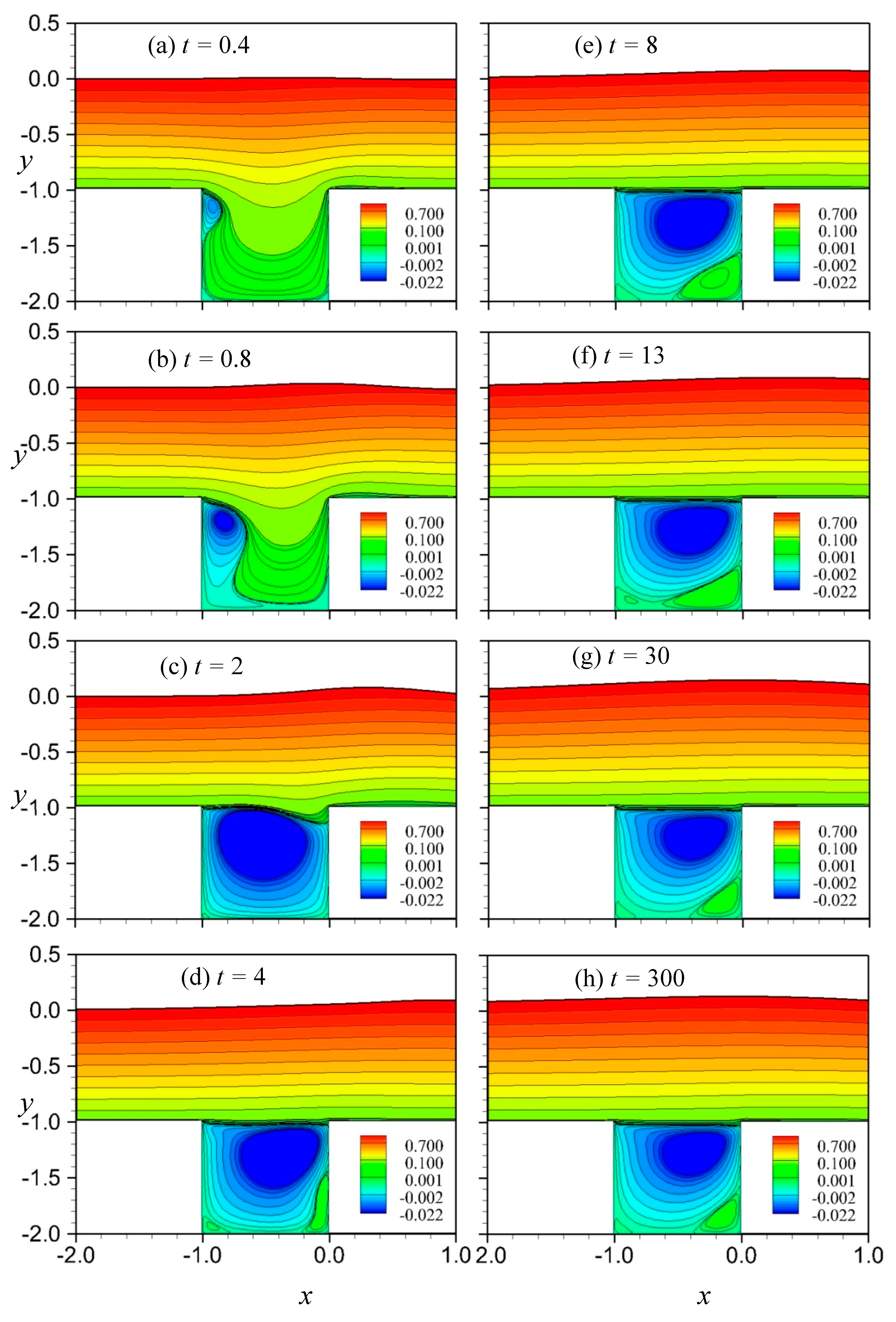


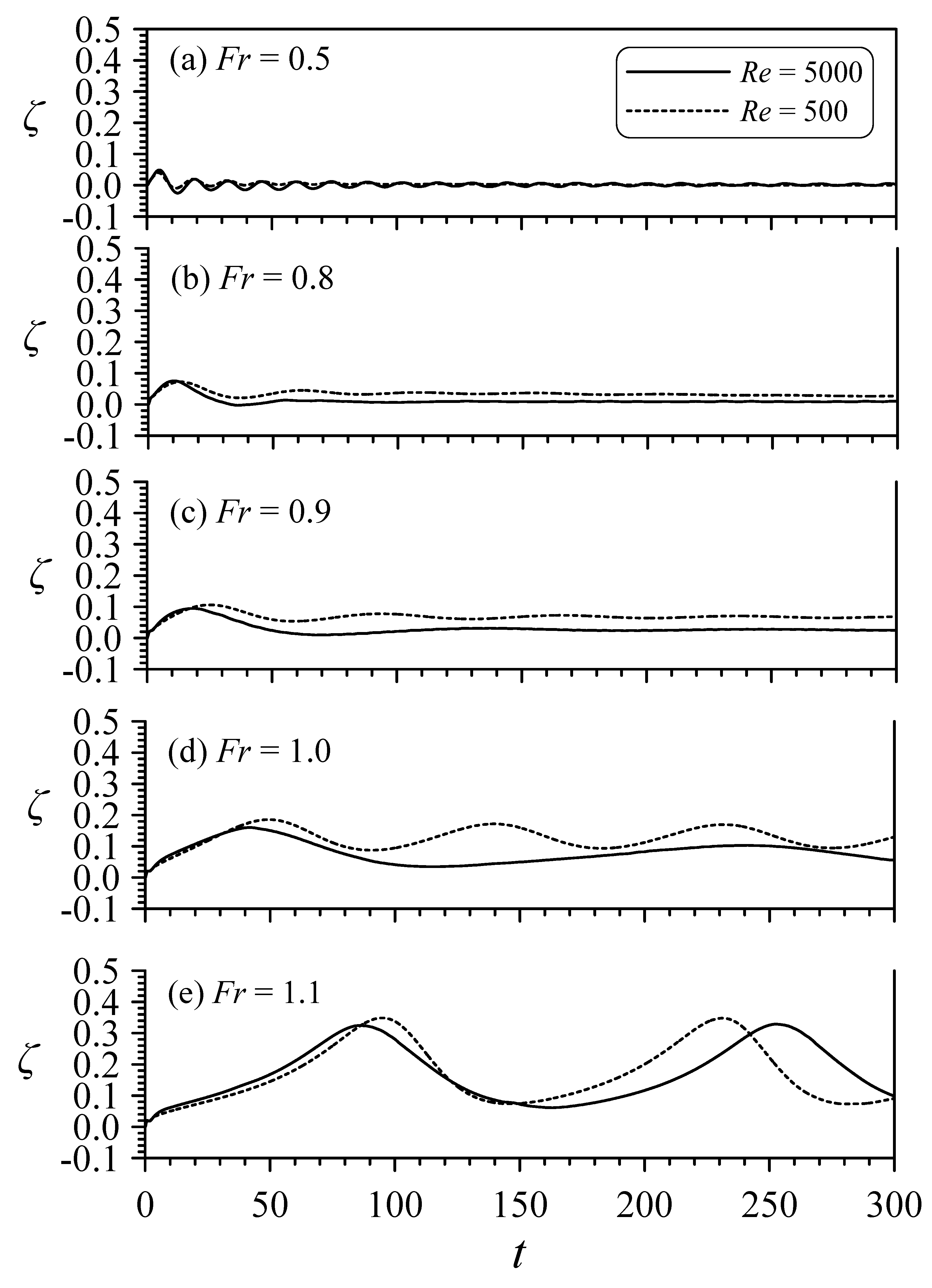


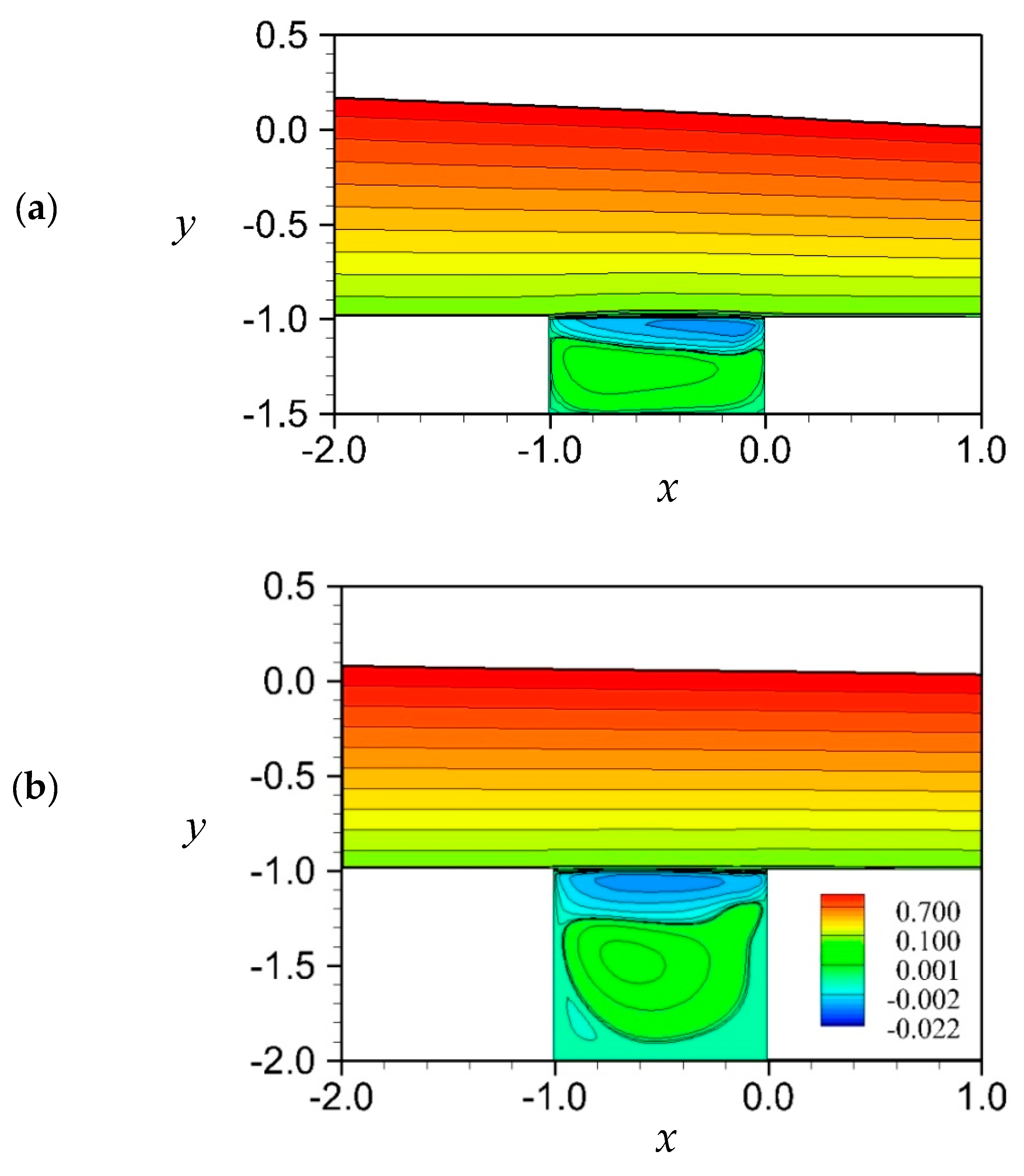
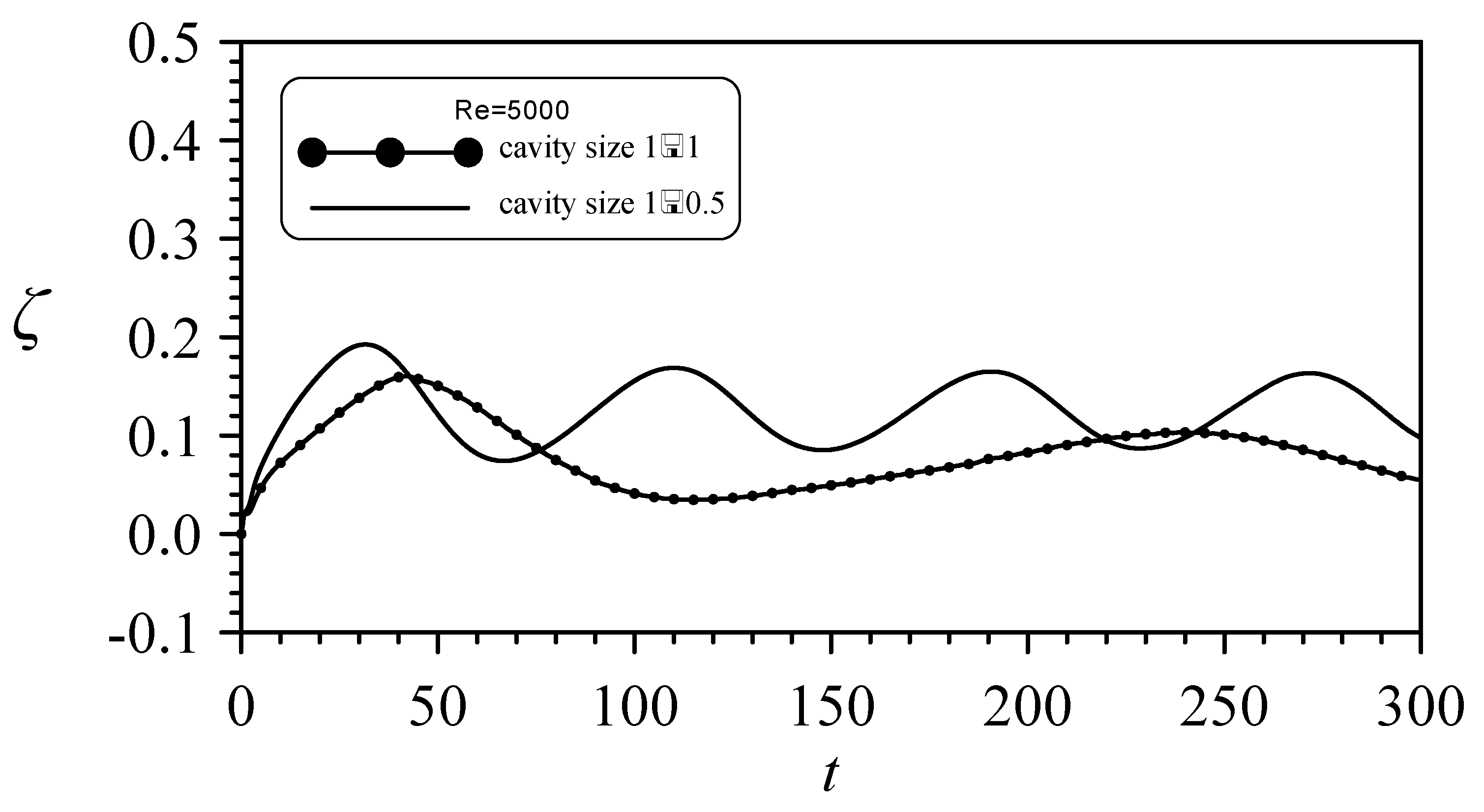
© 2019 by the author. Licensee MDPI, Basel, Switzerland. This article is an open access article distributed under the terms and conditions of the Creative Commons Attribution (CC BY) license (http://creativecommons.org/licenses/by/4.0/).
Share and Cite
Chang, C.-H. Numerical Analyses of Wave Generation and Vortex Formation under the Action of Viscous Fluid Flows over a Depression. J. Mar. Sci. Eng. 2019, 7, 141. https://doi.org/10.3390/jmse7050141
Chang C-H. Numerical Analyses of Wave Generation and Vortex Formation under the Action of Viscous Fluid Flows over a Depression. Journal of Marine Science and Engineering. 2019; 7(5):141. https://doi.org/10.3390/jmse7050141
Chicago/Turabian StyleChang, Chih-Hua. 2019. "Numerical Analyses of Wave Generation and Vortex Formation under the Action of Viscous Fluid Flows over a Depression" Journal of Marine Science and Engineering 7, no. 5: 141. https://doi.org/10.3390/jmse7050141
APA StyleChang, C.-H. (2019). Numerical Analyses of Wave Generation and Vortex Formation under the Action of Viscous Fluid Flows over a Depression. Journal of Marine Science and Engineering, 7(5), 141. https://doi.org/10.3390/jmse7050141



